-
Publish Your Research/Review Articles in our High Quality Journal for just USD $99*+Taxes( *T&C Apply)
Offer Ends On
W B Bozegha*
Corresponding Author: W B Bozegha, Numeration Science Literature, Development Research Project, Foubiri Sabagreia, Bayelsa State, Nigeria
Received: February 16, 2021 ; Revised: March 20, 2021 ; Accepted: March 23, 2021 ; Available Online: May 26, 2021
Citation: Bozegha WB. (2021) Genetic Code: One Pregnancy, Two Births. J BioMed Adv Clin Res, 1(1): 1-11.
Copyrights: ©2021 Bozegha WB. This is an open-access article distributed under the terms of the Creative Commons Attribution License, which permits unrestricted use, distribution, and reproduction in any medium, provided the original author and source are credited.
Views & Citations
Likes & Shares
Abstract
This is a talk reporting the twin phenomenon recently encountered in the genetic code. Two different fabrics of genetic code have come out of an elongated Punnett Square as output materials for a sequence of the four RNA bases, A,U,G,C (Adenine, Uracil, Guanine, Cytosine) implanted there as input set, after base crossing involving successive collateral posting (SCP) of the four bases to two different terminal digitalities of 3 and 4. The first birth at digitality 3 is a brood of 64 mixed triplets, (24 permutations and 40 non-permutations), while the second birth at digitality 4 is a brood of 24 permutation quadruplets after de-isodigitation of 232 non-permutation quadruplets. The circumstances of the single pregnancy and the two births of the two genetic code babies were incidental to a mathematician’s proposal in 1954 based on the formula, 43, to account for the molecular biologists’ observation in 1953, that the sequence of the RNA four bases A,U,G,C in the nucleus of a cell influenced the sequence of the twenty amino acids of protein in the surrounding cytoplasm of the cell and the scientists’ attempt of producing codewords to the tune of 43 from the four bases using Punnett Square and a subsequent revisit to the methodology of production of the desired codewords in 1990 by this author. The characteristics of the two babies are delineated in the light of combinatorial standards for permutation of 4 from 4 i.e., 4p4 = 4! and other properties of permutations such as potency, integrity, uniqueness and compatibility per factorial. Validation of each baby as the genetic code is made in the context of protein type proliferation and diversification, being the functional requirement of the genetic code in protein synthesis.
Keywords: Non-permutations, Permutations, Quadruplets, Triplets
INTRODUCTION
Molecular biologists observed in 1953 that the sequence of the four RNA nucleotide bases A, U, G, C (Adenine, Uracil, Guanine, Cytosine) in the nucleus of a cell influenced the sequence of the twenty amino acids of protein in the surrounding cytoplasm of the cell, as disclosed in The World of the Cell by Becker and Wayne [1]. They subsequently called the positional and quantitative relationship between the four nucleotide bases and the twenty amino acids of protein, the genetic code, as code-named in Cell Biology by Ambrose and Easty [2]. They tried to establish the relationship between the two entities in concrete terms of a code and raised a quantitative theoretical argument on how the four bases can be manipulated in form of combinations to raise enough codewords for the individual specification of the twenty amino acids of protein. The reasoning goes thus: If one base is used at a time only four words will be available. If two bases are in combination at a time, the four would give 42=4x4=16 duplex codewords, not enough for the twenty amino acids. If three bases are in combination, the four would give43 =4x4x4=64 triplet codewords; this time more than enough for the twenty amino acids, as argued in Cell Biology by, Ambrose and Easty [2]. Continuing the reasoning, using all four at a time would give 44 = 4x4x4x4=256 quadruplet codewords, far too much in excess of the twenty amino acids and therefore, discountenanced. They consequently settled on the 64 triplets and went about the generation of the needed codewords. They placed the four RNA bases A, U, G, C in a Punnett Square for genetic crossing involving collateral posting to digitality level 3 as illustrated in Table 1, thereby occasioning the pregnancy borne in our title. They enthusiastically went ahead to the laboratory to experimentally determine the allocation of the 64 triplet codewords to the respective twenty amino acids of protein and consequently declared their purported experimental allocations as illustrated in Table 1 as the spelling of the genetic code thereby confirming the first birth of the genetic code baby made up of a brood of 64 triplets as presented in Table 1 being the spelling adapted. The World of the Cell by Becker and Wayne [1] at digitality level 3. The body of this report carries the rest of the story relating to this baby and the birth of another genetic code baby from the same pregnancy sustained in genetic crossing extended to digitality level 4, and combinatoric examination of the two genetic code babies and their prospects in the World of Biological Sciences. But first definitions, illustrations, and annotations for easier advance.
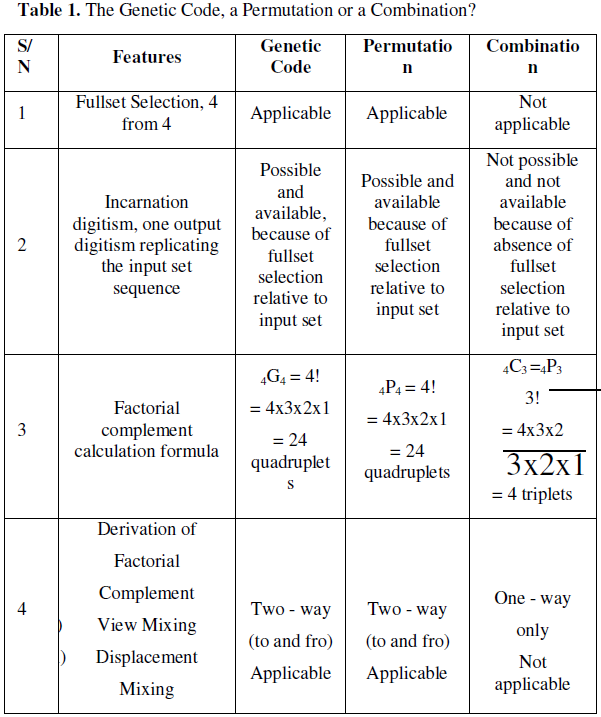
DEFINITIONS AND ILLUSTRATIONS
Combination: A group of things chosen from a larger number of dissimilar things without regard to order in the group.
Order: Means sequence of things in a set with regard to positions.
Permutation: Is anyone of the possible dissimilar objects taken all (fullset selection) or some (subset selection) at a time can be arranged in which order is important.
Pregnancy: In humans is the period during which an embryo grows within the womb. It begins at conception and ends at birth; the normal length is nine months.
Gestation: In humans is the period from fertilization to birth; has an average duration of nine months. A synonym of pregnancy.
Digitism: Digital composition of a number or simply, the set of digits in a number.
Isodigitism: Is the condition in a digitism whereby one or more digits are repeated. Isodigitism is disallowed in permutations and combinations as implied in the emphasis on dissimilarity of objects in the constituting set.
De-isodigitation: Is the elimination or removal of digitims affected by isodigitism. It is employed in the extraction of permutations from digibreed.
Digibreed: Is number population in sequence to a specified digitality generated by successive collateral posting of a given base-strength.
Caesarean Section means surgery for delivery of a baby. The second birth of the genetic code pregnancy or the second genetic code baby is a product of caesarean section.
Placenta: It is an ad-hoc infrastructure for servicing pregnancy in humans in all matters of developmental agenda of the embryo and fetus in the womb till childbirth. It grows physically with the pregnancy and must be delivered after childbirth in what is called stage-two labour for a safe delivery, as explained by Alma EG [3] Reader’s Digest Association Inc in ABC’s of the Human Body.
ANNOTATIONS
Input/Output Format: In the first place, divine creation as recorded in the Genesis Chapter 1 account of the Bible is the first, and supreme example of input/output format. The spoken word of God as input, and the resulting creation, the manifestation of matter, as the output material in the form of quantity (seen or unseen). It is the infrastructure for permutations and combinations. The genetic code is a striking natural example of a quantitative system featuring the input/output format and goes along with permutations in the matter of productivity and textural identity.
Input/output format is patronized by procreation in animal life and it is formally designated as pregnancy or gestation. Quantitative systems based on input/output format, such as, permutations, combinations, genetic code, pregnancy and crop farming have fixed laws governing their productivity and textural identity. Those of immediate interest include:
 for permutations
for permutations for combinations
for combinationsTEXTURAL SUBPOPULATIONS OF NUMBERS
The general number population can be subdivided into three subpopulations on textural basis; namely total isodigitals, partial isodigitals and non-isodigitals. In total isodigitals, all the digits of a digitism are repetitions of one particular digit e.g., 1111, 222, 33. In partial isodigitals, some of the digits of a digitism are repetitions of one or more digits: e.g., 5050, 122, 211, or the series 1, 10, 100, 1000 … The non-isodigitals have no repetition of any digits in their digitisms, e.g., 12, 314, 4321. A number of these textural subpopulations of numbers serve special interests in Numeration and Combinatorics. For instance, the partial isodigital series 1, 10, 100, 1000, … known as Incremental Digitality Counts (IDCs) in Numeration are used in meridian place location and as meridian place values in the organization of the entire number population of whatever base-strength. Similarly, the non-isodigital subpopulation of numbers is what combinatorics uses in fixing or computing the factorial complements for permutations and combinations for all specifications of set (n) and selection (r) and4G4 i.e., fullset selection 4 for genetic code. So, the texture of the fabric of the true genetic code as an example of permutation can only be made up of non-isodigital formations of A, U, G, C per formation and not otherwise as in the 64-triplet degenerate code which includes 40 isodigital triplets (4 total and 36 partial).
MATERIALS AND METHODS
The materials consist of the four RNA nucleotide bases, A, U, G, C. The method employs genetic crossing involving successive collateral posting of the four bases in Punnett Square to two different digitalities, one of 3 and the other of 4 as clarified below under (a) and (b).
Derivation of the 64-triplet genetic code by the indirect method of genetic crossing of A, U, G, C in an elongated Punnett Square to digitality level 3 without de-isodigitation (Chart 1).

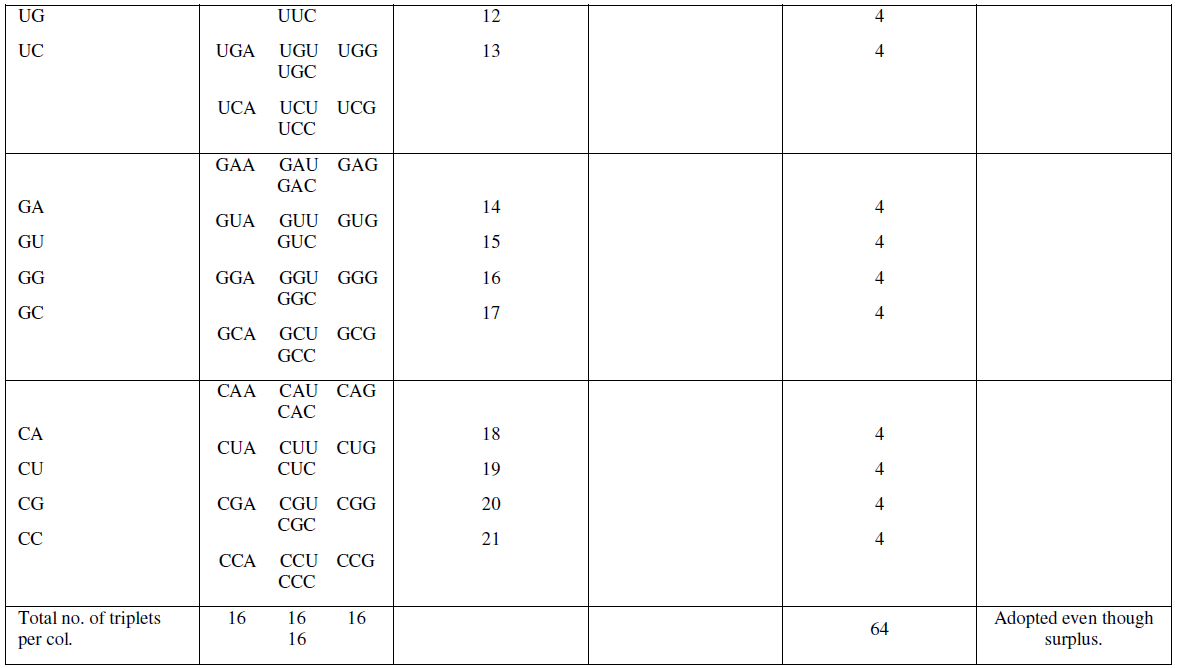 (b) Derivation of the 24-quadruplet genetic code by the method of genetic crossing of A, U, G, C in an elongated Punnett Square to digitality level 4 subjected to de-isodigitation (Chart 2).
(b) Derivation of the 24-quadruplet genetic code by the method of genetic crossing of A, U, G, C in an elongated Punnett Square to digitality level 4 subjected to de-isodigitation (Chart 2).
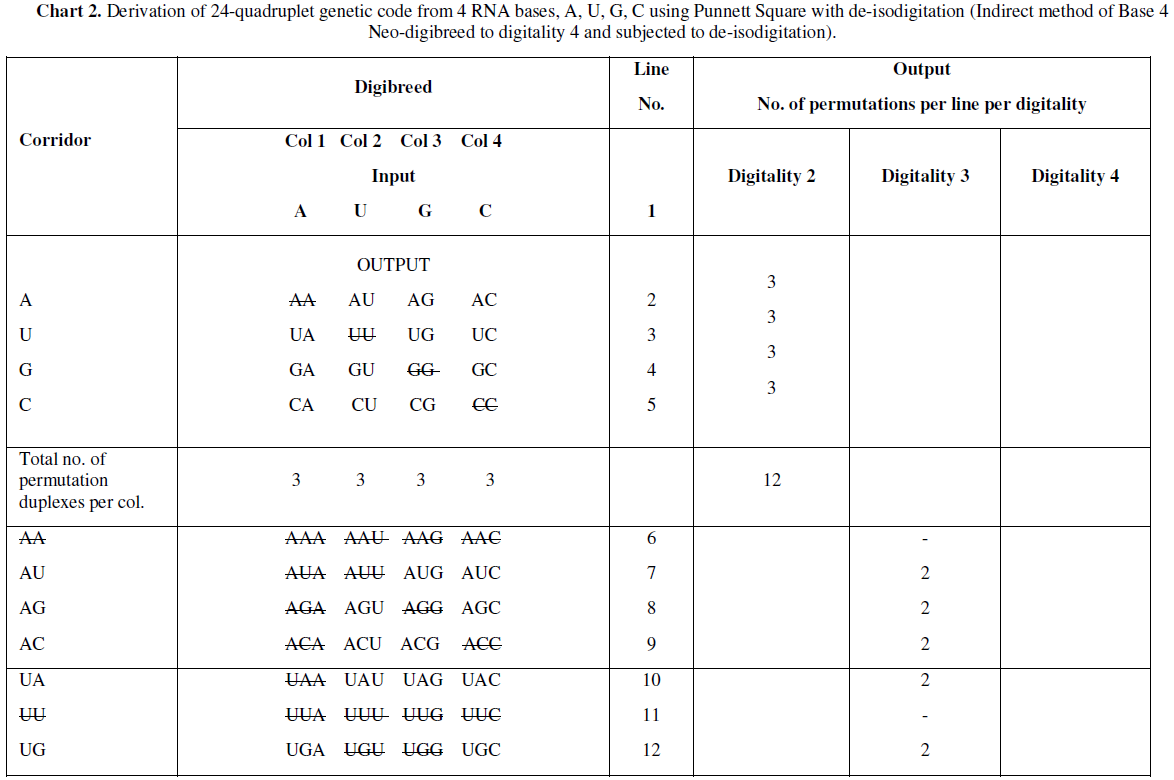
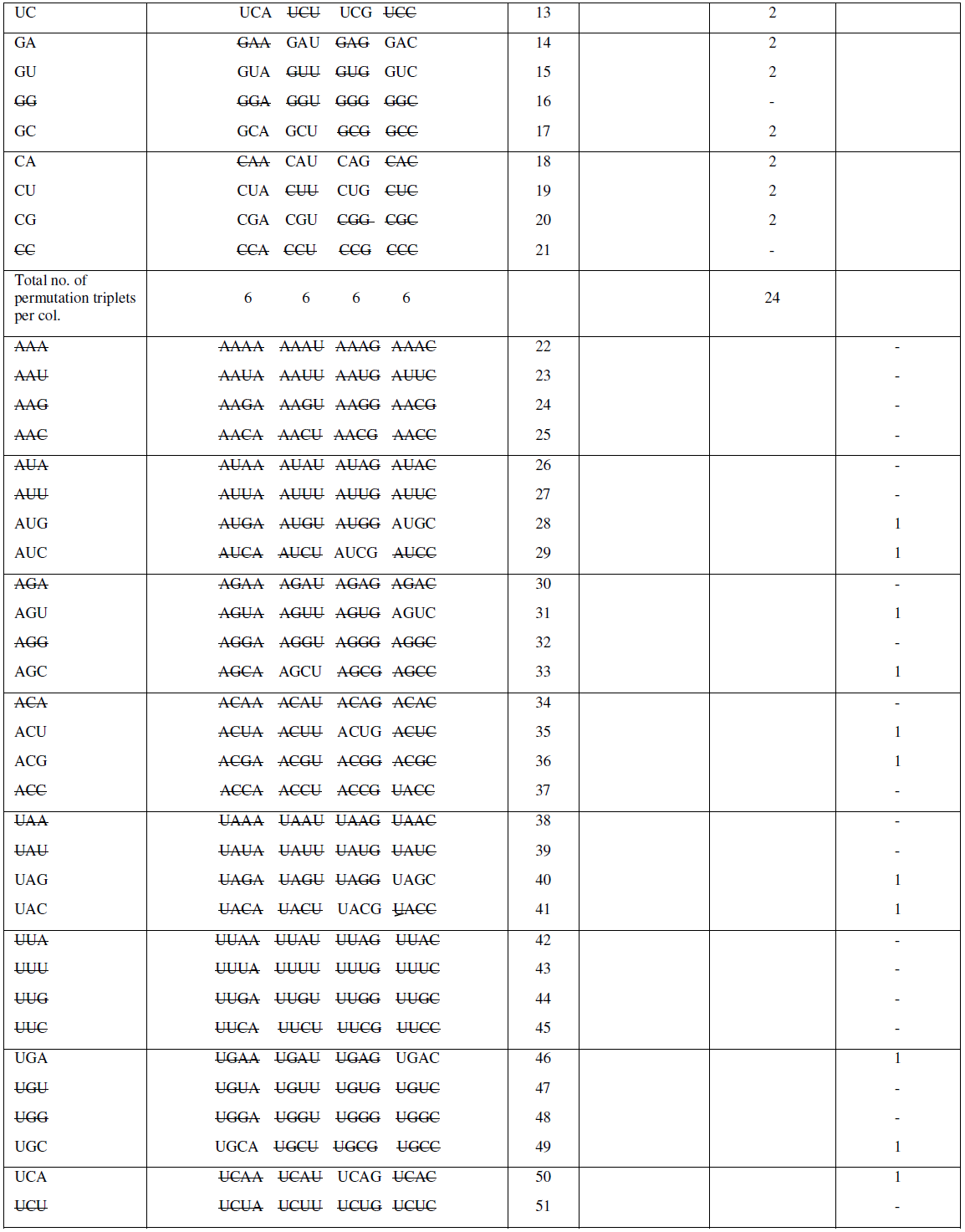
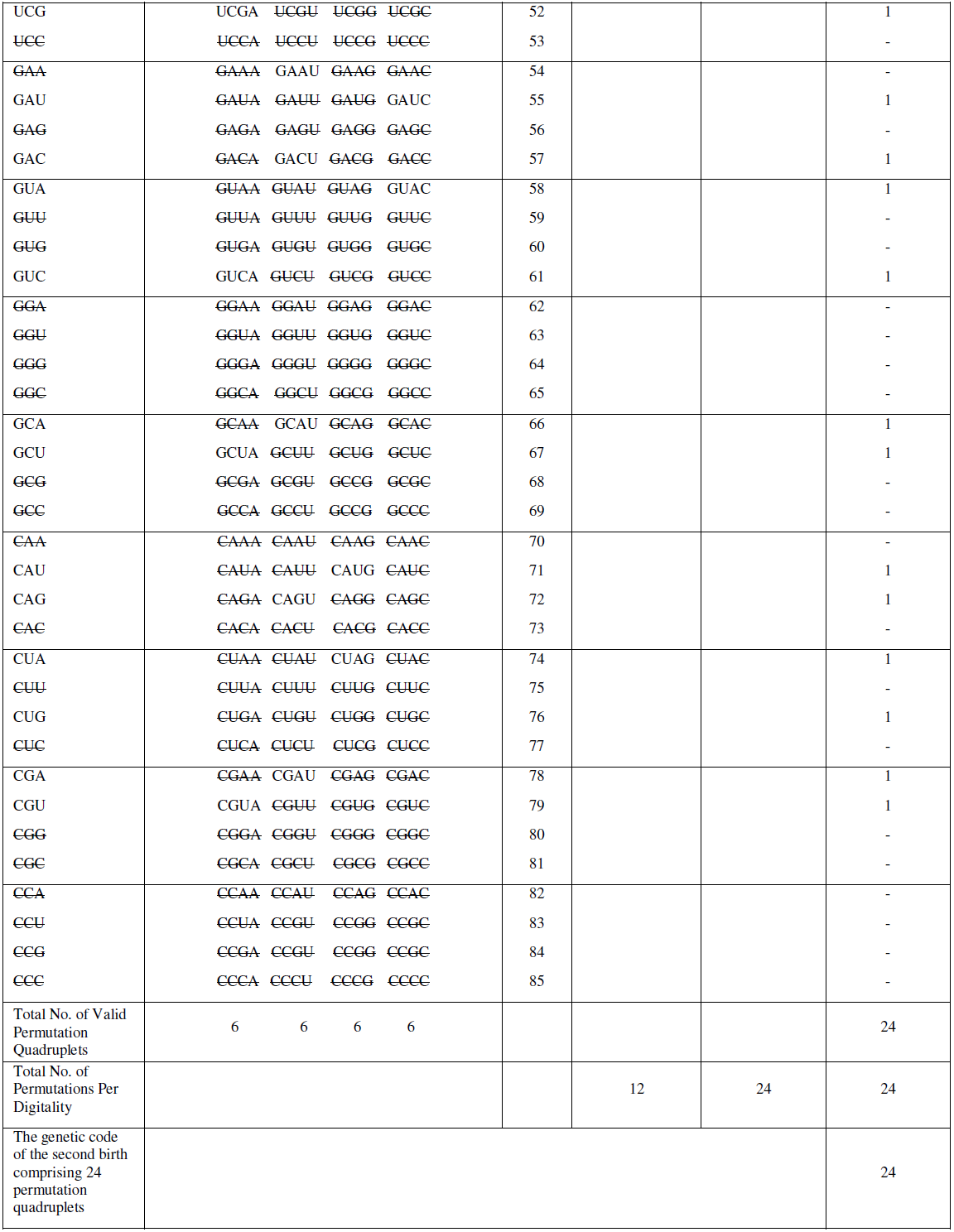
RESULTS
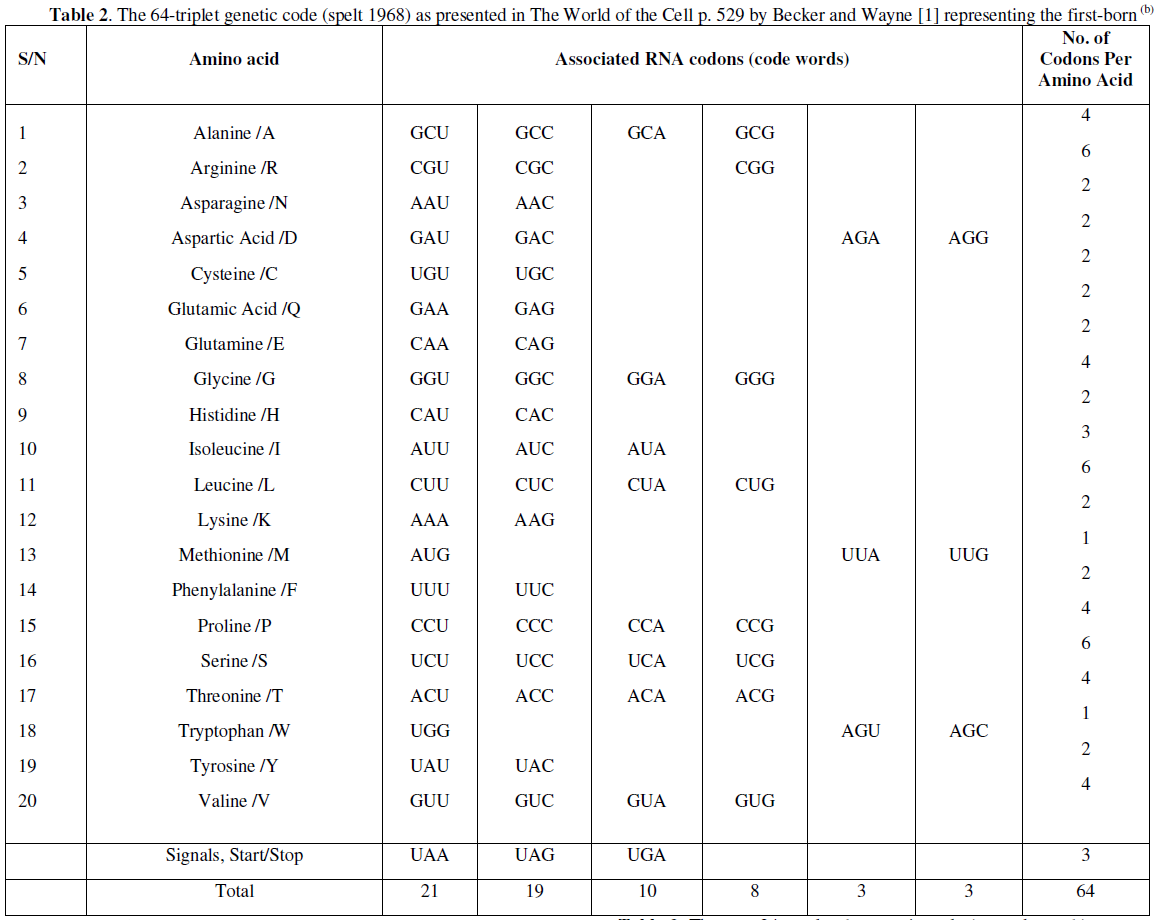
AUGC. AUCG. AGUC. AGCU. ACUG. ACGU. UAGC. UACG. UGAC. UGCA. UCAG. UCGA. GAUC. GACU. GUAC. GUCA. GCAU. GCUA. CAUG. CAGU. CUAG. CUGA. CGAU. CGUA.
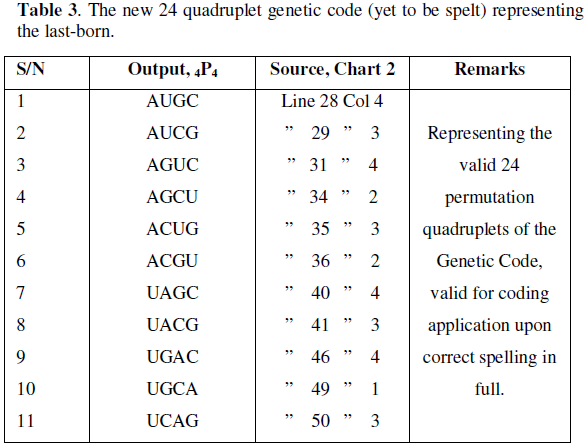
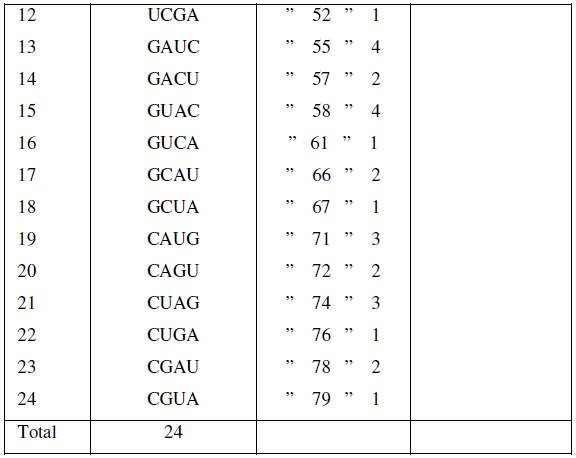
DISCUSSION
The Genetic Code Pregnancy
The input responsible for the pregnancy is the set of 4 RNA bases, A, U, G, C (Adenine, Uracil, Guanine, Cytosine) implanted in an elongated Punnett Square which serves effectively as the womb for viviparous gestation. It is in three developmental stages, just like that of humans. The human’s is divided into three trimesters (stages) on time basis, each of 3 months as presented by Alma EG [3] in Reader’s Digest Association Inc. in ABC’s of the Human Body. whereas that of the genetic code is divided on digitality basis into three stages; first of digitality 2 for a brood of 16 duplets, given by 42second of digitality 3 for a brood of 64 triplets, given by 43 third of digitality 4 for a brood of 256 quadruplets, given by 44as carried in Tables 1 and 2 before de-isodigitation. The brood of 16 duplexes at digitality 2 of the genetic code pregnancy includes a placenta of 4 isodigital duplexes; brood of 64 triplets at digitality 3 includes a placenta of 40 isodigital triplets, while the brood of 256 quadruplets at digitality 4 of the genetic code pregnancy includes a placenta of 232 isodigital quadruplets which must be successfully separated and discarded in order to bring the genetic code pregnancy to the desired birth of a genetic code of 24 quadruplet permutations of the RNA four bases (A,U,G,C) in unique sequences characterized by integrity.
In the light of today’s advances in computational combinatorics, equipped with techniques for computing permutations of specified set (n) and selection (r) e.g., 4 from 4, as in the case of deriving the genetic code from a sequence of the four nucleotide bases A, U, G, C, it is unnecessary to resort to the elongated Punnett Square for the derivation of the genetic code from the four nucleotide bases, that gave rise to the unwanted pregnancy. But in 1954 in the absence of direct permutation computation techniques, the scientists had to resort to elongated Punnett Square, the only known probable resource apparatus, whereby pregnancy is inevitable and unavoidable, but they were not also aware that this is only an indirect source of the derivation that required separation of permutations from non-permutation for validity of products as codons.
The genetic code pregnancy was mismanaged, in that the first birth was prematurely induced to make delivery at digitality 3 on account of the output forecast formula, 43, applicable to base 4 neo-digibreed population at digitality 3, used in the scientists’ derivation effort. The premature birth is evident in the immaturity of the brood of triplets as the output from a quadruplet input set of four RNA bases.
To the Numeration Scientists the first birth of the genetic code prematurely induced at digitality 3 that comprised 64 mixed triplets, 24 of permutations representing an immature baby and 40 of non-permutations, representing the placenta is a clear evidence of mismanaged delivery on two grounds: one of allowing 40 non-permutation triplets comprising the placenta in the genetic code that is only properly constituted by 24 quadruplet permutations; and the other of allowing triplets at all in a genetic code where only quadruplets are entitled to be. It is a mismanaged delivery for mistaking the placenta for a baby and thereby retaining it as part of the immature genetic code baby of 64 triplets.
MATURITY OF GENETIC CODE BIRTH
The three conditions of premature, mature and post mature (post-term) birth found in human experience as explained in ABC’s of the Human Body by Alma EG [3] are also encountered in the genetic code birth phenomenon. The genetic code maturity of birth is based on the input set 4 (digitism comprising A, U, G, C) which is specific. Any output digitism less than 4 of non-isodigital digitism is premature, and any output digitism more than 4 of non-isodigital digitism is post term or post mature. Both the pre- and the post- are not tolerated, because of obvious discrepancies in digital texture and population concerning the expected babies. The 64-triplet brood of genetic code baby of the first birth at digitality level 3 is therefore premature and unacceptable, being triplets instead of quadruplets in consonance with the input set of 4 digits in the context of permutation tenets.
FIRST BIRTH OF GENETIC CODE BABY
The birth of the first genetic code baby brood of 64 triplets embodying 40 isodigital (non-permutation) triplets that represent the placenta at digitality level 3 in Table 1 was midwifed by molecular biologists and took place when no permutation computational techniques were available. It was premature birth emotionally induced by molecular biologists, who were not so much aware that only permutations can make the fabric of the true genetic code. They took no cognizance of the prematurity at the stage of digitality 3, nor of the mixed textual status of the brood of 64 triplets made up of 24 permutations (non-isodigitals) and 40 non-permutations (isodigitals) representing the placenta and accepted all as the genetic code baby, now known to be only the first of two babies. It is full of combinatorial discrepancies traditionally described as irregularities in genetics literature. It was nurtured to adulthood and accorded with acceptability by way of full ‘spelling’ carried out in 1968 and adopted thereupon since then, in spite of the prevailing irregularities which are irreconcilable with the inerrancy of NATURE, and also a miscarriage of the objective of the substitution phenomenon in protein synthesis, whereby 4 nucleotide bases were substituted for 20 amino acids of protein as input set in the input/output multiplicative replication combinatorial system for necessary protein type proliferation and diversification. By spelling it is meant the biochemical experimental determination of the allocations of the respective 64 triplets to the 20 amino acids of protein and signals. The spelt 64 triplet genetic code is another breach of truth in science, like the hitherto flat earth.
SECOND BIRTH OF ANOTHER GENETIC CODE BABY
The birth of the second genetic code baby from the one pregnancy at digitality level 4 depicted in Table 2 was doctored by this author, a combinatorist and took place in the early 1990s. It was mature though notionally suppressed until the situation came to the notice of this author; a Numerationist turned a combinatorist who intervened. He successfully used de-isodigitation, a kind of caesarean section to bring out the baby brood of 24 permutation quadruplets alive from the genetic code pregnancy, whereby 232isodigitals (non-permutations) representing the placenta were discarded or denied parturition. The genetic code baby of the second birth is in perfect condition. It is in agreement with the combinatorial characteristics of (a) Maturity, being of digitality 4 as the input set 4; (b) Comprising non-isodigitals (permutations) only;(c) Population strength given by 4G4 = 4P4 = 4! = 4x3x2x1 = 24 quadruplets as demanded of factorial complements for fullset selection of 4 from 4 for genetic code computation as a species of permutation. This second genetic code baby is presented in Table 2 and is yet to be spelt.
WHY THE GENETIC CODE IS A SPECIES OF PERMUTATION AND NOT COMBINATION
This distinction between permutation and combination is reminiscent of DNA test for determination of a baby’s father in disputed cases of paternal identity, as depicted in Table 1.
The genetic code in science is in the setting of substitution phenomenon in protein synthesis, where instead of using a sequence of the 20 amino acids of protein directly as input set in the combinatorial input/output multiplicative replication system for the proliferation and diversification of protein types, a sequence of the RNA four bases is used as input set in the multiplicative replication system for turning out permutations capable of undertaking the desired proliferation and diversification. The genetic code of 24 RNA permutation quadruplets is the output of the input set of one RNA permutation quadruplet. The genetic code of 24 permutation quadruplets reflects proliferation and diversification of the RNA quadruplet to the tune of 24 times, thus justifying its substitution and use in protein synthesis requiring proliferation and diversification of protein type in moderation and adequacy.
The agreement between genetic code and permutation on all the criteria of identification and the disagreement between genetic code and combination on the same criteria used in Table 1 clearly show that the genetic code is a species of permutation and not combination.
CHARACTERISTICS OF THE TWO GENETIC CODE BABIES
The characteristics of the two babies presented in Table 4 are only illustrative and not exhaustive.
FINDINGS
The first baby born at digitality3 comprising a brood of 64 mixed triplets, (24 permutations and 40 non-permutations) based on 43 of base 4 neo-digibreed population at digitality 3 is in serious disagreement with the output of 4 from 4 permutations i.e., 4P4 = 4! = 4x3x2x1 = 24 quadruplets and is found to be unfit to represent the genetic code of 24 quadruplet permutations derivable from a sequence of 4 nucleotide bases taken at fullset selection of 4. The second baby born at digitality 4 comprising a brood of 24 permutation quadruplets being the residue after de-isodigitation of 232 quadruplets out of the 256 quadruplets at digitality4 base 4 neo-digibreed population, is found fit to represent a genetic code sequence of 24 permutation quadruplets.
CONCLUSION AND SIGNIFICANCE
The first twin baby of 64 triplets admixed with placenta of 40 isodigital triplets being in serious structural disagreement with the true genetic code of 24 permutation quadruplets is unfit to bear the name of genetic code, not to talk of representing it anywhere in coding application in protein synthesis/studies. The second twin baby of 24 permutation quadruplets, being the output of 4 from 4 permutations, like the true genetic code, is actually the replica of the genetic code in Nature, that is engaged in protein type proliferation and diversification in protein synthesis since Creation. More importantly, this new 24-quadruplet genetic code exhibits collinearity with protein type of 20 amino acids at one codon per amino acid with four spare codons for four start/stop control signals for time and place during protein synthesis, thus qualifying as the workforce of strength 24 in protein synthesis. The collinearity between the genetic code and protein type is to the effect of active proliferation and diversification of the latter.
The significance is that the correct version of the true genetic code of 24 permutation quadruplets is now available to the World of Science for continued utilization.
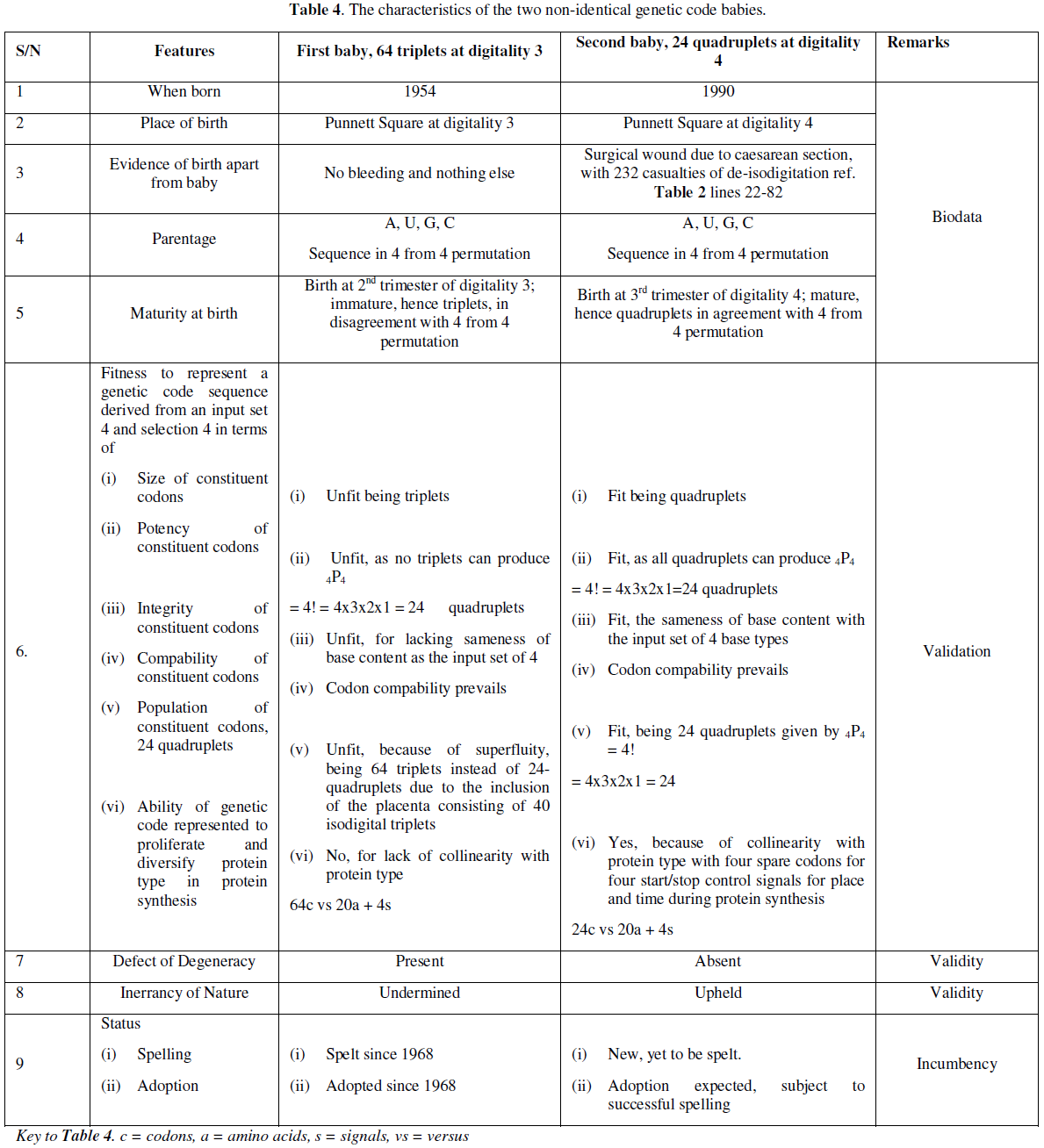
RECOMMENDATION
Let experimental experts in molecular biology and genetics work on the spelling of this new 24-quadruplet genetic code in order to render it fit for adoption in coding application in protein synthesis/studies.
REFERENCES
No Files Found
Share Your Publication :